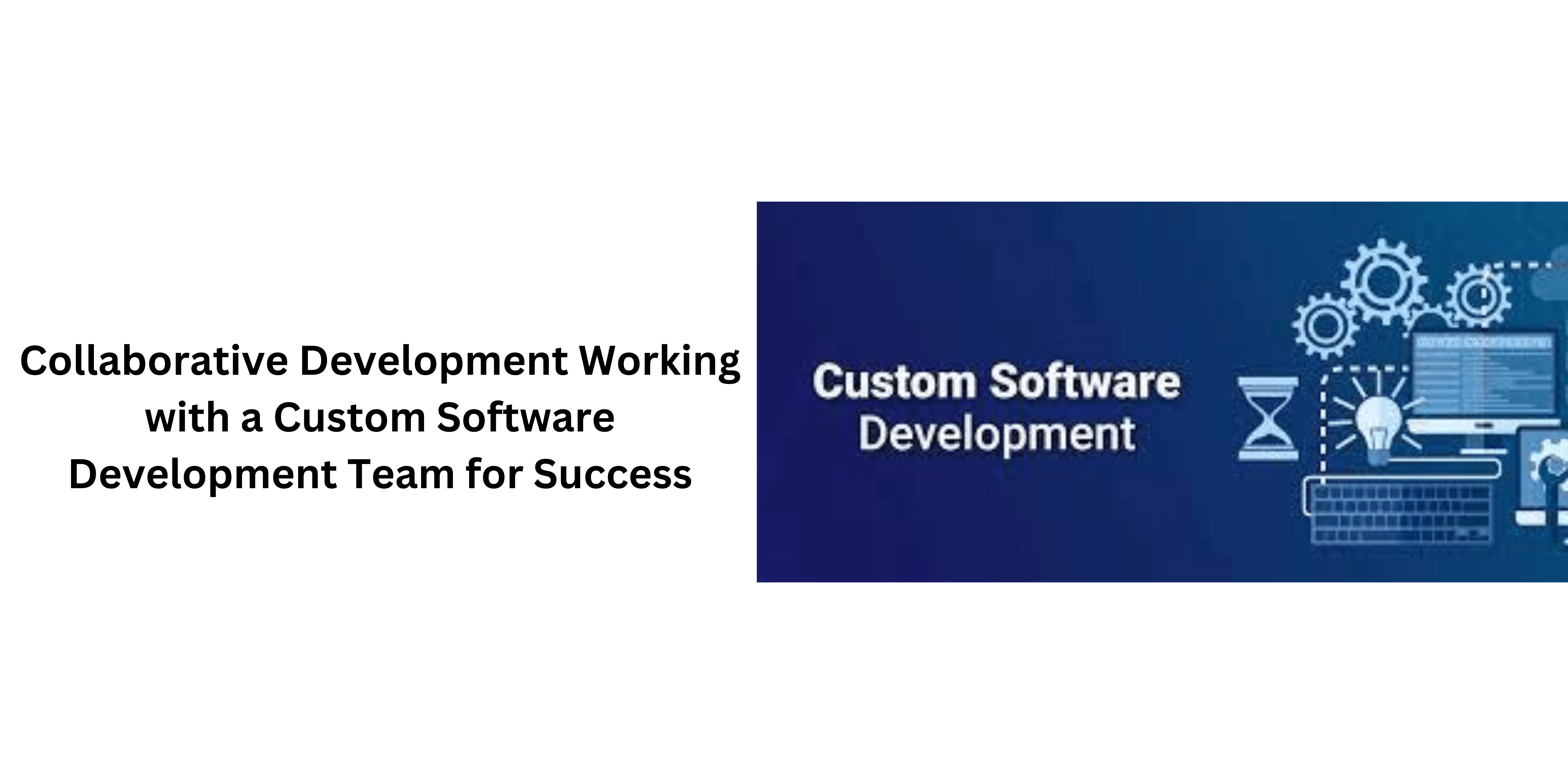In the rapidly evolving landscape of software development, achieving success often hinges on the seamless collaboration of dedicated professionals within a custom software development team. The essence of collaborative development lies in fostering an environment where individuals with diverse skill sets unite to create innovative solutions tailored to meet specific client needs. This collaborative synergy extends beyond mere coordination, encompassing effective communication, shared responsibility, and an iterative approach to development.
This introduction delves into the intricate dynamics of collaborative development, exploring the key components that contribute to the success of a custom software development team. From the utilization of agile methodologies to the implementation of efficient communication strategies and collaboration tools, each facet plays a crucial role in ensuring the cohesive functioning of the team. As we navigate through the subsequent sections, we will unravel the strategies and best practices that lead to triumph in the realm of collaborative development, emphasizing the significance of cross-functional teams, client engagement, and the pursuit of continuous improvement.
Key Components of a Custom Software Development Team
The success of a custom software development team relies on a carefully orchestrated interplay of key components, each contributing to the collective efficiency and innovation of the group.
Diverse Skill Sets
A well-rounded team brings together individuals with a diverse array of skills, including coding, design, testing, and project management. This diversity ensures a comprehensive approach to problem-solving.
Effective Communication
Clear and open communication is the cornerstone of any successful team. Regular team meetings, transparent discussions, and active collaboration help prevent misunderstandings and foster a positive working environment.
Agile Methodology
Implementing agile methodologies allows for flexibility and adaptability in the face of evolving project requirements. Agile practices promote iterative development, continuous feedback, and the ability to respond promptly to changing client needs.
Project Management
Robust project management is crucial for keeping the team on track. This involves setting realistic goals, creating timelines, and allocating resources effectively. Project managers play a pivotal role in coordinating tasks and ensuring everyone is aligned with project objectives.
Collaboration Tools
Utilizing modern collaboration tools enhances team efficiency. Platforms for version control, issue tracking, and communication streamline workflow and facilitate real-time collaboration, irrespective of geographical distances.
Client Engagement
Involving the client throughout the development process ensures that the end product aligns with their expectations. Regular updates, feedback sessions, and client participation contribute to the success of the project.
Cross-functional Teams
Integrating individuals with different specialties into cross-functional teams promotes a holistic approach to problem-solving. This enables the team to tackle challenges from various perspectives and ensures a comprehensive solution.
Quality Assurance and Testing
A dedicated focus on quality assurance and testing is imperative for delivering a robust and error-free software product. Thorough testing at each stage of development helps identify and rectify issues early on.
By cultivating these key components, a custom software development team lays the groundwork for a collaborative and effective work environment, ultimately paving the way for successful project outcomes.
Effective Team Communication Strategies
Effective team communication is the lifeblood of successful collaboration within a custom software development team. Clear and open communication not only fosters a positive working environment but also plays a pivotal role in preventing misunderstandings, aligning team members, and enhancing overall productivity.
Regular Team Meetings
Schedule regular team meetings to discuss project updates, address concerns, and share insights. These meetings provide a platform for team members to voice their opinions, ask questions, and stay informed about the project’s progress.
Use of Collaboration Tools
Leverage modern collaboration tools such as project management software, messaging platforms, and video conferencing tools. These tools facilitate real-time communication, document sharing, and collaborative editing, breaking down geographical barriers and ensuring everyone is on the same page.
Clear Communication Channels
Establish clear communication channels within the team. Clearly define roles and responsibilities, and ensure that team members know whom to approach for specific queries or concerns. This minimizes confusion and promotes efficient problem-solving.
Open and Transparent Communication
Foster a culture of openness and transparency. Encourage team members to share their thoughts, ideas, and concerns freely. When communication is transparent, it builds trust within the team, leading to better collaboration.
Active Listening
Encourage active listening among team members. This involves truly understanding and considering others’ perspectives. Active listening promotes a deeper understanding of project requirements and helps prevent misinterpretations.
Constructive Feedback
Provide and receive constructive feedback. Constructive criticism, when communicated effectively, helps team members improve their work and contributes to the overall growth of the team.
Documenting Communication
Keep a record of important discussions, decisions, and action items. This documentation serves as a reference point for team members and helps in avoiding repetitive discussions.
By adopting these communication strategies, a custom software development team can create a conducive environment for collaboration, ensuring that everyone is well-informed, engaged, and working towards common goals. Effective communication is not only a tool for conveying information but also a mechanism for building strong team dynamics.
Agile Methodology and its Role in Success
Agile methodology has emerged as a cornerstone in the success of custom software development services, providing a flexible and iterative approach to project management. It prioritizes adaptability, collaboration, and customer feedback throughout the development process, fostering a dynamic environment that responds effectively to changing requirements.
Flexibility and Adaptability
Agile embraces change, recognizing that requirements evolve as the project progresses. This flexibility allows teams to respond swiftly to emerging challenges and integrate new features or adjustments seamlessly, ensuring the final product aligns closely with client expectations.
Iterative Development
Agile operates on an iterative development model, breaking down the project into small, manageable increments called iterations or sprints. Each iteration produces a functional piece of the software, allowing for continuous testing, refinement, and adaptation. This iterative cycle contributes to a more responsive and fine-tuned end product.
Continuous Customer Involvement
Customer collaboration is a core principle of agile methodology. Regular feedback from clients during and after each iteration ensures that the development team remains aligned with client expectations. This iterative feedback loop helps in refining the software based on real-world usage and evolving client needs.
Increased Team Collaboration
Agile encourages close collaboration among team members, promoting shared ownership of the project. Cross-functional teams work collaboratively throughout the development cycle, breaking down silos and fostering a sense of collective responsibility.
Rapid Delivery of Value
By delivering functional increments at the end of each iteration, agile ensures that clients receive tangible value early in the development process. This not only keeps stakeholders engaged but also allows for prompt adjustments based on real-time feedback.
Risk Mitigation
Agile’s incremental and iterative approach enables teams to identify and address potential risks early in the development process. This proactive risk management contributes to a more reliable and stable project outcome.
In summary, the Agile methodology’s emphasis on adaptability, iterative development, customer collaboration, team collaboration, rapid value delivery, and risk mitigation collectively plays a pivotal role in the success of custom software development teams. It aligns the development process with the dynamic nature of software projects, fostering a culture of continuous improvement and client satisfaction.
Project Planning and Management in Collaborative Development
Project planning and management are critical aspects of collaborative development, ensuring that a custom software development team operates efficiently, stays on track, and successfully delivers high-quality solutions. Effective project planning and management involve several key elements:
Define Clear Objectives
The first step in project planning is to establish clear and measurable objectives. Understand the client’s requirements and expectations, and articulate project goals that align with these parameters. This provides a roadmap for the development team.
Break Down Tasks and Set Milestones
Divide the project into smaller, manageable tasks and set achievable milestones. This approach allows for better tracking of progress, identifies potential bottlenecks early on, and facilitates a more realistic assessment of timelines.
Resource Allocation
Identify and allocate resources, including human resources, tools, and technology, based on the project’s requirements. Effective resource allocation ensures that the team has the necessary support to meet project goals efficiently.
Risk Assessment and Mitigation
Conduct a thorough risk assessment to identify potential challenges and uncertainties. Develop strategies to mitigate risks, and have contingency plans in place. This proactive approach minimizes the impact of unexpected events on project timelines and outcomes.
Utilize Project Management Tools
Leverage project management tools to streamline communication, collaboration, and task tracking. These tools enhance visibility into project progress, facilitate team coordination, and contribute to overall efficiency.
Establish a Communication Plan
Define a communication plan that outlines how team members will communicate and share updates. Regular status meetings, progress reports, and open lines of communication ensure that everyone is informed and aligned.
Adaptability to Change
Project management in collaborative development must be adaptable. Embrace changes in requirements or scope, and be prepared to adjust plans accordingly. Agile project management methodologies, such as Scrum, support this adaptive and iterative approach.
Continuous Monitoring and Evaluation
Implement a system for continuous monitoring and evaluation of the project’s progress. Regularly assess whether the team is meeting objectives, staying within timelines, and delivering the expected quality. Use feedback to make necessary adjustments.
In summary, effective project planning and management in collaborative development involve a strategic approach to goal-setting, task breakdown, resource allocation, risk mitigation, communication, adaptability, and continuous evaluation. When executed meticulously, these elements contribute to the success of custom software development projects by ensuring that they are delivered on time, within budget, and with the desired level of quality.
Utilizing Collaboration Tools for Efficiency
Utilizing collaboration tools is integral to enhancing the efficiency and effectiveness of a custom software development solutions. In the fast-paced and interconnected world of collaborative development, these tools serve as a linchpin for seamless communication, streamlined workflows, and overall productivity. Several key aspects highlight the importance of incorporating collaboration tools:
Real-time Communication
Collaboration tools provide channels for real-time communication, allowing team members to connect instantly regardless of geographical locations. Instant messaging, video conferencing, and discussion forums foster quick decision-making and the exchange of ideas.
Document Sharing and Version Control
Platforms for document sharing and version control ensure that team members have access to the latest project documents and code repositories. This prevents duplication of work, reduces errors, and maintains a centralized source of truth for project assets.
Task and Project Management
Collaboration tools equipped with task and project management features enable teams to organize, assign, and track tasks efficiently. These tools provide transparency into project progress, deadlines, and individual responsibilities.
Code Collaboration
Version control systems and code collaboration platforms facilitate collaborative coding efforts. Multiple developers can work on the same project simultaneously, with changes tracked and merged seamlessly. This promotes collaboration within the coding phase of the development process.
Integration with Development Environments
Collaboration tools that integrate with development environments enhance workflow efficiency. Seamless integration allows developers to access collaboration features without disrupting their coding processes, promoting a more cohesive development experience.
Automated Workflows
Implementing collaboration tools with automated workflows reduces manual intervention, streamlining repetitive tasks and ensuring consistency. This automation accelerates processes, minimizes errors, and allows team members to focus on more strategic aspects of development.
Knowledge Sharing and Documentation
Collaboration tools enable knowledge sharing through wikis, documentation repositories, and shared knowledge bases. This ensures that valuable insights, solutions, and best practices are documented and readily accessible to the entire team.
In conclusion, the strategic use of collaboration tools is indispensable for fostering efficiency within a custom software development team. By optimizing communication, enabling seamless collaboration on code and project assets, and automating routine processes, these tools contribute significantly to the overall success of collaborative development efforts.
Creating a Collaborative Development Culture
Creating a collaborative development culture is pivotal for fostering innovation, boosting team morale, and ultimately achieving success in custom software development projects. This culture goes beyond mere cooperation; it is a shared mindset and set of practices that prioritize open communication, mutual respect, and collective problem-solving. Several key strategies contribute to building a collaborative development culture:
Shared Goals and Vision
Clearly articulate the overall goals and vision of the project to ensure that all team members are aligned. A common understanding of the project’s purpose creates a sense of unity and shared purpose.
Open Communication Channels
Encourage open and transparent communication at all levels. Team members should feel comfortable expressing their ideas, concerns, and feedback. Establishing regular forums for discussion fosters a culture of inclusivity.
Cross-functional Collaboration
Break down silos by promoting cross-functional collaboration. Facilitate interactions between individuals with different skill sets and expertise, encouraging the exchange of ideas and diverse perspectives.
Team Empowerment
Empower team members by giving them a sense of ownership over their work. When individuals feel valued and empowered, they are more likely to contribute actively to the collaborative culture and take initiative.
Continuous Learning and Improvement
Foster a culture of continuous learning and improvement. Encourage team members to share knowledge, experiences, and best practices. Regularly conduct retrospectives to reflect on the project’s successes and challenges, promoting a mindset of continuous improvement.
Celebrate Achievements
Acknowledge and celebrate both individual and team achievements. Recognizing accomplishments boosts morale, reinforces a positive culture, and motivates team members to excel in their collaborative efforts.
Flexibility and Adaptability
Cultivate a culture that embraces change and adapts to evolving project requirements. Being flexible in the face of challenges and open to adjusting strategies contributes to a more resilient and collaborative team.
Mentorship and Collaboration Events
Facilitate mentorship programs and organize collaboration events. Pairing experienced team members with newcomers fosters knowledge transfer, while collaboration events create opportunities for team building and relationship-building.
In summary, creating a collaborative development culture is a holistic endeavor that involves aligning goals, promoting open communication, encouraging cross-functional collaboration, empowering team members, fostering continuous learning, celebrating achievements, and embracing flexibility. When these elements are ingrained in the team’s ethos, it sets the stage for a dynamic and collaborative environment that propels custom software development projects towards success.
The Importance of Cross-functional Teams
Cross-functional teams play a crucial role in the success of custom software development projects by bringing together individuals with diverse skills, expertise, and perspectives. The importance of cross-functional teams lies in their ability to address complex challenges, promote innovation, and deliver well-rounded solutions. Here are key reasons why cross-functional teams are essential in the realm of software development:
Diverse Skill Sets
Cross-functional teams consist of members with varied skill sets, including developers, designers, testers, and project managers. This diversity ensures that the team possesses a comprehensive range of expertise necessary for different aspects of the development process.
Holistic Problem-Solving
Complex software projects often requires multifaceted solutions. Cross-functional teams approach problem-solving from multiple angles, leveraging the strengths of each team member to address diverse challenges comprehensively.
Faster Decision-Making
With representatives from different disciplines present, cross-functional teams can make decisions more rapidly. Real-time collaboration allows for quicker problem identification, evaluation of potential solutions, and implementation of decisions.
Improved Communication
Communication is enhanced within cross-functional teams as members with distinct roles collaborate closely. This reduces the likelihood of misunderstandings and ensures that information flows seamlessly across different phases of the development process.
Adaptability to Change
In the dynamic landscape of software development, requirements may evolve. Cross-functional teams are inherently adaptable, capable of responding to changes swiftly and efficiently, ensuring the project remains aligned with evolving client needs.
Increased Accountability
Every team member in a cross-functional team has a specific role and responsibility. This fosters a sense of ownership and accountability, as each individual understands their contribution’s impact on the overall project.
Enhanced Innovation
Collaboration between individuals with diverse perspectives sparks innovation. Cross-functional teams encourage the exchange of ideas, best practices, and creative solutions, fostering an environment where novel approaches can thrive.
Efficient Project Management
Cross-functional teams often streamline project management by integrating tasks seamlessly across different disciplines. This integrated approach minimizes bottlenecks, reduces handovers, and improves overall project efficiency.
In conclusion, the importance of cross-functional teams in custom software development solutions cannot be overstated. Their ability to leverage diverse skills, promote holistic problem-solving, enhance communication, adapt to change, increase accountability, foster innovation, and streamline project management contributes significantly to the success of software development endeavors.
Iterative Development and Continuous Improvement
In iterative development, a project is broken down into smaller, manageable cycles or iterations. Each iteration involves planning, designing, implementing, testing, and evaluating a functional portion of the software. This iterative cycle repeats, allowing for regular release of improved versions of the software. The benefits of iterative development include:
- Early and Regular Feedback: Iterative cycles enable early and continuous feedback from clients and end-users. This feedback loop is essential for refining the software based on real-world usage and evolving requirements.
- Adaptability to Changes: Iterative development embraces change by allowing for modifications and additions to the software in response to evolving client needs or unforeseen challenges. This flexibility ensures that the final product is better aligned with client expectations.
- Reduced Risk of Failure: Breaking the project into smaller iterations reduces the risk of large-scale project failure. Issues can be identified and addressed early, minimizing the likelihood of catastrophic errors in the final product.
Continuous Improvement:
Continuous improvement involves the ongoing refinement of processes, methodologies, and outcomes. This principle extends beyond the development phase and encompasses the entire project lifecycle. Key aspects of continuous improvement include:
- Regular Retrospectives: Conducting regular retrospectives allows the team to reflect on what worked well and what could be improved. This reflective practice encourages a culture of continuous learning and adaptation.
- Feedback Loops: Establishing feedback loops within the team and with stakeholders facilitates ongoing improvements. This includes not only feedback on the software but also on team dynamics, communication, and project management processes.
- Implementation of Best Practices: Continuous improvement involves the implementation of best practices identified through experience, industry standards, and emerging trends. This ensures that the team is always striving for higher efficiency and quality.
By embracing iterative development and continuous improvement, custom software development teams create a resilient and adaptive environment. This approach not only enhances the quality of the delivered software but also contributes to the team’s overall growth and success over time.
Custom Solutions Tailored to Client Needs
Tailoring custom solutions to meet specific client needs is a cornerstone of successful software development. This client-centric approach involves understanding the unique requirements, challenges, and goals of the client and crafting solutions that address these aspects. Here’s why custom software solutions tailored to client needs are crucial:
Client Satisfaction
Custom solutions are designed with the client’s specific needs in mind, leading to higher levels of satisfaction. When clients receive software that aligns closely with their requirements, it enhances their overall experience and trust in the development process.
Alignment with Business Objectives
Tailored solutions ensure that the software directly supports the client’s business objectives. This alignment contributes to the efficiency and effectiveness of the client’s operations, ultimately impacting the organization’s success.
Optimized User Experience
Understanding the end-user’s needs allows for the creation of user interfaces and experiences that are intuitive, user-friendly, and aligned with the workflow of those who will interact with the software regularly. This optimization enhances user adoption and satisfaction.
Scalability and Flexibility
Custom solutions can be designed to accommodate future growth and changes in the client’s business. The flexibility to scale the software or introduce new features ensures that the solution remains relevant and supportive as the client’s needs evolve.
Competitive Advantage
Tailored solutions provide a competitive edge by offering features and functionalities that are unique to the client’s requirements. This distinctiveness can set the client apart in their industry and contribute to market leadership.
Efficient Resource Utilization
By focusing on specific client needs, development efforts are directed toward features and functionalities that directly contribute to the client’s objectives. This efficient resource allocation results in a more cost-effective and impactful solution.
Collaborative Partnership
Building custom solutions fosters a collaborative partnership between the client and the development team. Regular communication and feedback loops ensure that the solution evolves in response to changing requirements and emerging insights.
Risk Mitigation
Tailored solutions involve close collaboration with the client throughout the development process, reducing the risk of misunderstandings and misalignments. Iterative feedback loops allow for adjustments, minimizing the chances of delivering a product that does not meet expectations.
In conclusion, custom solutions tailored to client needs are paramount for delivering software that not only meets technical specifications but also aligns with the unique business objectives and operational requirements of the client. This client-centric approach not only enhances the success of individual projects but also fosters long-term collaborative partnerships.
Balancing Creativity and Structure in Team Collaboration
Balancing creativity and structure in team collaboration is a delicate yet essential aspect of custom software development. Striking the right equilibrium between fostering innovation and maintaining organizational coherence is crucial for achieving successful outcomes. Here’s why finding this balance is important:
Fostering Innovation
Creativity is the driving force behind innovation. Encouraging a culture of creativity within a team cultivates an environment where members feel empowered to think outside the box, propose novel ideas, and explore unconventional solutions to complex problems.
Structured Framework for Efficiency
While creativity is essential, a structured framework provides the necessary guidance for efficient collaboration. It establishes processes, roles, and workflows that help manage tasks, allocate resources effectively, and maintain project timelines. This structure ensures that creativity is channelled toward productive ends.
Alignment with Project Objectives
A balance between creativity and structure ensures that innovative ideas are aligned with the overall project objectives. A structured approach helps translate creative concepts into actionable plans, ensuring that the team’s efforts are directed toward achieving project goals.
Effective Communication
Clear communication is vital in maintaining the delicate balance between creativity and structure. Establishing open channels for idea-sharing and feedback, while also adhering to structured communication protocols, ensures that creative insights are integrated into the development process seamlessly.
Flexibility within Parameters
A balanced approach allows for flexibility within established parameters. While adhering to project guidelines and timelines, teams can explore creative solutions that may enhance the project’s quality or address unforeseen challenges.
Motivation and Engagement
A balance between creativity and structure keeps team members motivated and engaged. The freedom to innovate instills a sense of ownership and passion, while the structure provides a sense of stability and purpose.
Problem-Solving Dynamics
Creative thinking often leads to innovative problem-solving. A structured framework ensures that these creative solutions are implemented systematically, leading to effective resolutions.
Continuous Improvement
Balancing creativity and structure foster a culture of continuous improvement. Regularly evaluating and refining both creative processes and structured workflows allows the team to evolve and adapt over time.
In conclusion, the synergy between creativity and structure in team collaboration is indispensable for achieving success in custom software development. A balanced approach encourages an environment where innovative ideas thrive within a framework that provides guidance, efficiency, and a clear path towards achieving project objectives.
Overcoming Challenges in Collaborative Development
Collaborative development, while highly beneficial, comes with its set of challenges that teams must navigate to ensure project success. Overcoming these challenges requires a combination of effective communication, proactive problem-solving, and a commitment to fostering a collaborative culture.
Communication Barriers
Diverse teams may face language barriers, time zone differences, or varying communication preferences. Mitigating these challenges involves establishing clear communication channels, utilizing collaboration tools, and promoting an inclusive culture where all team members feel comfortable expressing themselves.
Coordination and Synchronization
With team members working on different aspects of a project simultaneously, coordination and synchronization can become challenging. Implementing agile methodologies, utilizing project management tools, and regular team meetings help ensure that everyone is on the same page and progress aligns with project timelines.
Conflict Resolution
Differences in opinions and approaches can lead to conflicts within the team. Encouraging open communication, providing channels for conflict resolution, and fostering a culture that values diverse perspectives contribute to constructive conflict resolution.
Misalignment with Client Expectations
Understanding and aligning with client expectations can be challenging. Establishing clear communication channels with clients, regular updates, and involving clients in the development process through feedback loops help ensure that the final product meets their expectations.
Technical Challenges
Teams may encounter technical challenges that require collaborative problem-solving. Promoting knowledge sharing, encouraging team members to seek help when needed, and maintaining an environment where learning from challenges is valued can help overcome technical hurdles.
Maintaining Team Morale
Extended project timelines or unexpected challenges may impact team morale. Recognizing and celebrating achievements, providing support during challenging periods, and fostering a positive team culture contribute to maintaining high morale.
Balancing Individual and Team Contributions
Achieving a balance between individual contributions and collaborative teamwork is crucial. Recognizing and valuing both individual expertise and collaborative efforts ensures that team dynamics remain harmonious.
Adapting to Change
Collaborative development often involves adapting to changing project requirements. Promoting a flexible and adaptive mindset, incorporating agile methodologies, and maintaining effective communication channels help teams navigate changes seamlessly.
Overcoming challenges in collaborative development requires a proactive and holistic approach. By addressing communication barriers, coordinating effectively, resolving conflicts, aligning with client expectations, tackling technical challenges, maintaining team morale, balancing contributions, and adapting to change, teams can create an environment conducive to successful collaborative software development projects.
Measuring Success in Custom Software Projects
Measuring success in custom software projects involves assessing various factors that contribute to the project’s effectiveness, client satisfaction, and overall impact. Successful outcomes are often a result of meeting project goals, adhering to timelines, delivering high-quality software, and ensuring client expectations are not only met but exceeded.
Goal Achievement
The extent to which the project achieves its predefined goals is a primary measure of success. These goals may include functionality requirements, performance metrics, and specific deliverables outlined in the project scope.
Client Satisfaction
Client satisfaction is a key indicator of project success. Regular communication, feedback loops, and client involvement throughout the development process contribute to a positive client experience. Client satisfaction surveys or reviews provide valuable insights.
Quality of Deliverables
The quality of the delivered software is a critical measure. Assessing the functionality, reliability, security, and performance of the software against predefined standards ensures that the end product meets or exceeds expectations.
Adherence to Timelines and Budget
Successful projects are often those that adhere to established timelines and budget constraints. Consistently meeting milestones, delivering on time, and staying within budget demonstrate effective project management and execution.
User Adoption and Experience
The extent to which end-users adopt and engage with the software is a measure of its success. A positive user experience, intuitive design, and efficient functionality contribute to higher user satisfaction and increased adoption rates.
Flexibility and Adaptability
Successful projects demonstrate flexibility and adaptability to changes in requirements or unforeseen challenges. The ability to pivot, adjust strategies, and maintain momentum in the face of change contributes to overall project success.
Post-Implementation Support and Maintenance
Providing effective post-implementation support and maintenance is crucial for sustained success. Timely bug fixes, updates, and responsive support contribute to the long-term viability of the software.
Return on Investment (ROI)
Assessing the ROI of the project involves measuring the economic benefits gained against the costs incurred. Successful projects deliver value that justifies the investment made by the client or organization.
Team Satisfaction and Collaboration
The satisfaction and collaboration among team members also contribute to project success. A positive team dynamic, effective collaboration, and a shared sense of achievement reflect a successful project culture.
In summary, measuring success in custom software projects involves a multifaceted evaluation of goal achievement, client satisfaction, deliverable quality, adherence to timelines and budget, user adoption, flexibility, post-implementation support, ROI, and team satisfaction. By assessing these factors comprehensively, teams can gauge the overall success and impact of their custom software projects.
Client Involvement and Feedback in the Development Process
Client involvement and feedback are integral components of the custom software development process, ensuring that the end product aligns with client expectations, meets business requirements, and fosters a collaborative and transparent development environment.
Requirement Understanding
Active client involvement at the outset is essential for understanding project requirements. Through collaborative discussions and workshops, development teams gain insights into the client’s vision, goals, and specific needs, laying the foundation for a successful project.
Iterative Development and Feedback Loops
In an agile development environment, continuous client involvement is encouraged through iterative development cycles. Regular feedback loops allow clients to review incremental releases, provide input, and guide the development team toward adjustments or enhancements.
Real-time Decision-Making
Client involvement facilitates real-time decision-making. Clients can make informed choices about features, functionalities, and priorities as they witness the software evolve. This agile decision-making process ensures that the final product closely aligns with their expectations.
Transparency and Communication
Regular client involvement promotes transparency in the development process. Open communication channels, progress updates, and transparent reporting create an atmosphere of trust and collaboration, keeping clients informed about project status and potential challenges.
Addressing Changes Promptly
Client feedback allows for prompt identification and addressing of changes or adjustments. Whether it’s altering requirements, refining features, or adapting to new insights, addressing changes in real-time ensures that the development stays on track and aligned with client needs.
Validation of Deliverables
Client involvement during the testing phase is crucial for validating deliverables. Client feedback in this stage ensures that the software meets quality standards and that any identified issues are resolved promptly.
Risk Mitigation
Active client involvement contributes to risk mitigation. Early and continuous client feedback helps identify potential risks, challenges, or misalignments, allowing the development team to address these issues before they escalate.
Client Satisfaction and End-User Experience
Ultimately, client involvement ensures client satisfaction and a positive end-user experience. By actively participating in the development process, clients contribute to the creation of a product that not only meets their expectations but also resonates with end-users.
In conclusion, client involvement and feedback in the custom software development process are essential for project success. From the initial requirement understanding to iterative development cycles, transparent communication, and validation of deliverables, client involvement ensures that the development process is collaborative, responsive, and aligned with the client’s vision and business objectives.
Building Long-Term Success through Collaborative Partnerships
Building long-term success through collaborative partnerships is a strategic approach in bespoke software development that extends beyond individual projects, focusing on establishing enduring relationships with clients. This collaborative and partnership-oriented mindset is key to achieving sustained success and mutual growth.
Understanding Client Goals
Building a long-term partnership begins with a deep understanding of the client’s business goals, challenges, and vision. This understanding forms the basis for developing customized solutions that align with the client’s long-term objectives.
Continuous Communication and Engagement
Maintaining open and continuous communication is vital for collaborative partnerships. Regular updates, feedback sessions, and engagement throughout the development process foster a sense of collaboration and transparency.
Proactive Problem Solving
Long-term success is built on the ability to proactively identify and address challenges. Collaborative partnerships involve a shared responsibility for problem-solving, with the development team actively contributing insights and solutions to ensure project success.
Scalability and Flexibility
Collaborative partnerships are characterized by scalability and flexibility. As a client’s business evolves, the development team must be adaptable, ready to scale solutions, and introduce new features to meet changing needs.
Shared Ownership of Success
A collaborative partnership is marked by shared ownership of success. Both the client and development team take pride in achieving project milestones and delivering successful outcomes, reinforcing the strength of the partnership.
Strategic Planning for the Future
Long-term success involves strategic planning for the future. Collaborative partnerships entail discussions about long-term roadmaps, technology trends, and potential innovations, ensuring that both parties are prepared for future challenges and opportunities.
Value Addition Beyond Development
Building a collaborative partnership goes beyond the development phase. Providing value-added services such as ongoing support, maintenance, and strategic consultations reinforces the commitment to the client’s sustained success.
Trust and Relationship Building
Trust is the foundation of a collaborative partnership. Consistent delivery of high-quality solutions, transparent communication, and a commitment to meeting and exceeding expectations build a strong foundation of trust between the client and development team.
In summary, building long-term success through collaborative partnerships involves a holistic approach that prioritizes understanding client goals, continuous communication, proactive problem-solving, scalability, shared ownership of success, strategic planning, value addition beyond development, and the establishment of trust. By fostering collaborative and enduring relationships, development teams contribute not only to the success of individual projects but also to the overall growth and success of their clients.
The Key Takeaway
In conclusion, collaborative development stands as a dynamic and iterative process where diverse teams come together, leveraging creativity, structure, and client involvement to craft tailored solutions. Success in custom software projects hinges on effective communication, adaptability, and the ability to balance individual contributions with team dynamics.
Embracing agile methodologies, client feedback loops, and a commitment to continuous improvement propels projects toward achieving goals and surpassing client expectations. Building long-term success extends beyond individual projects, involving strategic partnerships, mutual trust, and shared ownership of achievements.
As development teams navigate challenges, embrace client-centric approaches, and foster collaborative cultures, they not only deliver high-quality software but also contribute to the sustained growth and success of their clients and organizations. Collaborative development, at its core, is a journey of innovation, adaptability, and shared triumphs, laying the groundwork for future advancements in the ever-evolving landscape of custom software development.











